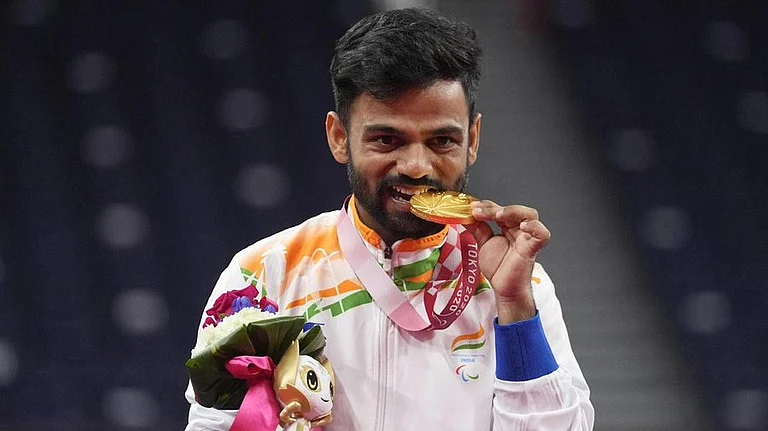Radha and Krishna
Lord Krishna was known for his dark complexion, around which there are many stories and songs. When young Krishna complained to his mother Yashoda about his dark complexion, his companion Radha was fair-skinned. On this innocent complaint, Yashoda jokingly said to appease his son to color Radha in the color that resembles his skin color. Naively Krishna went to color Radha and this amusing play became a custom for generations ahead. Today, the festival of Holi which is driven by the Radha and Krishna Legend is known as Krishna Holi celebrated prominently in areas associated with the childhood of Krishna like Mathura, Vrindavan, Barsana, Gokul, and Nandgaon.
Kamdeva and lord Shiva
In Hindu Mythology, Kamadeva is known for being the god of love and desire, who is responsible for awakening these feelings in the hearts of beings through his arrows. As per the legend, the story begins with the demon Tarkasura, who has obtained a boon from Lord Brahma to be invincible to anyone except the son of Lord Shiva.
While all the Lords were tensed about the malice of the demon, recently windowed Lord Shiva was grieving the loss of his wife Sati devoted himself to a deep meditation state. Shiva had given up on all worldly desires of any kind, which led to Kamadeva having to use his powers to get Shiva out of his mediation state.
Knowing well enough about Shiva’s low temper, Kamadeva accompanied by his wife Rati, decided to shoot his arrow on lord Shiva for the greater good. The act evoked Shiva’s third eye and in the tempered state, he burned Kamadeva with his powers, this day is said to be marked by Holika Dahan.
Despite this action, the bows of Kamadeva worked on lord Shiva and led him to marry Parvati, who then had a son named Kartikeya. Later on, Kartikeya defeated Tarkasura and ended the misery of the lords.
This legend observes the sacrifice of lord Kamadeva, teaching the value of working for the greater good and highlighting the power of love and sacrifice. This Holi is known as Kamanna Holi and is celebrated in southern India. Idols of Kamadeva or Kamanna are installed and worshipped throughout the week. This practice is mainly observed in the Ramalingeshwara temple located in Karnataka.
Hiranyakasyapu and Prahlad
This well-known tale of Holi, which revolves around the story of Demon Hiranyakashyapu and Prahlad originates with the boon close to immortality. Filled with extreme arrogance and ambition, Hiranyakashyapu was invulnerable to humans, animals, weapons, and any living or non-living being. Despite Hiranyakashyapu’s utter hatred towards Lord Vishnu, his son Prahlad stayed rigid on the path of devotion towards lord Vishnu. Filled with hatred and arrogance, he tried many ways to kill his son, one of them being using his Sister’s powers to kill Prahlad.
It is believed that Holika, the sister of Hiranayakashyapu was immune to fire, in an attempt to kill Prahlad, she sat on fire with him sitting on her lap. Due to Lord Vishnu’s intervention to save his devotee, Prahlad left the fire unharmed while Holika burned to ashes. This day is known as Holika Dahan, on which people gather and observe the victory of good over evil. In many parts of India, the story of Holika is prominent and considered direct to Holi.
Ogress Dhundhi
One prevalent folklore coming from the state of Gujarat is the lore of Ogress Dhundhi. Dhundhi the ogress was known for causing sickness in children, in the village of Raghu, located near Prayagraj. She received a boon from lord Shiva, which made her invincible, except for loud young boys.
Tired of Dhundhi’s antics, the villagers came up with a solution and planned a set up of young boys and built a fire. These boys would circle the fire and cause distress to the ogress by loud chanting, laughing, shouting insults for her, and making drum noises. This commotion persisted until the ogress, feeling vexed and defeated, finally left the village.
Ogress Pootna
The mention of Demoness Pootna can not go unnoticed when it comes to the story of lord Krishna. Feared by a prophecy predicting the downfall of Kansa by the hand of his nephew, Kansa tried everything to ensure the demise of Krishna. One of the demons, Kansa sent to kill Krishna was demoness Pootna. She entered the village disguised as a beautiful woman, pretending to be a caring mother to breastfeed Krishna with poison.
However, the divine incarnation recognized Pootna's malevolent intent and sucked the life force out of the demoness. Regardless of her continued struggle, the demoness failed to escape from the grasp of Krishna and eventually perished.
This episode is often recounted during the celebration of Holi, among other occasions, as it symbolizes the themes of victory, protection, and the destruction of evil forces by the divine.
In the end, Holi in India is not limited to the celebration colors but is also rich with many mythological stories and legends. These folklores are the heart of this festival and are being passed on from many generations. We can not choose which one to believe in, but surely all of these tales add meaning and depth to the festival itself. Perhaps, we need more tales to celebrate the teaching of how good always wins over evil, how strong faith defeats negativity, or maybe it is an occasion to be playful with your loved ones, who knows?



























